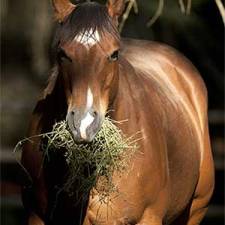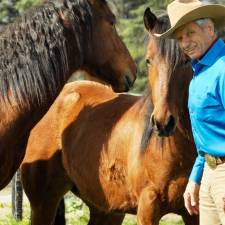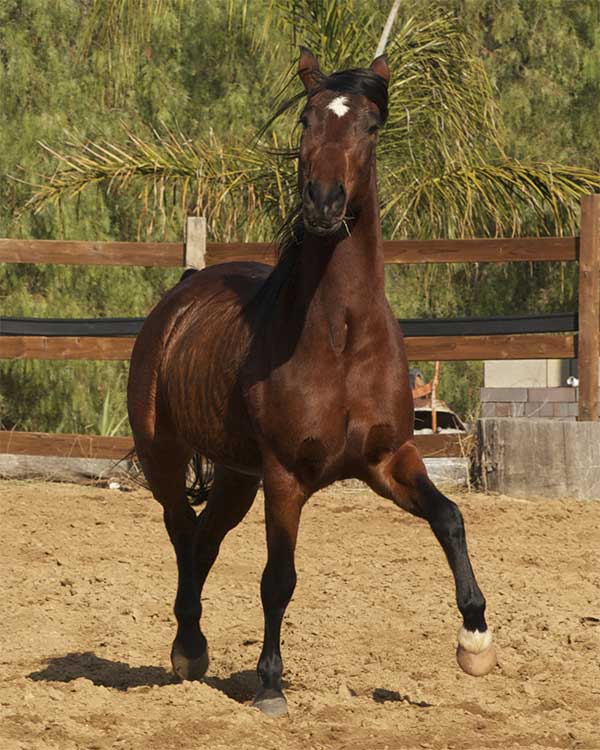
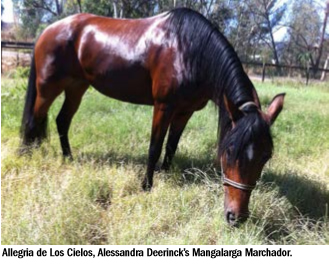
By Alessandra Deerinck
I am always open something new, and even more if it is about horses.
Throughout my life I competed in jumping, flat racing, dressage and trail, and in 2009 I rode in my first endurance ride, a fifty-mile ride in Warner Springs on an Arabian stallion. At the same time I was working with a client who needed a horse with a smooth gait because he had lost part of a leg in an accident. He loved trail riding, and in searching for a horse breed that suited him I came across the Mangalarga Marchador.
Marchador was, indeed, the name of the first one I have met. The horse’s white coat immediately captured my eye. He was as lively as an Arabian and as graceful as a Spanish horse. His gait piqued my curiosity; it was fast and smooth, but very unusual, almost on a horizontal line, lacking of vertical movement. He was almost hovering above the ground, looking like a real Pegasus. This beautiful gait was natural, and his other gaits were also worth noticing. Marchador was truly a horse with another gear! I have never ridden him, but shortly after learning about the breed, I started to work with Jacob Martinez and his wife, Dr. Teresa Longo, owners of Rancho de Los Cielos, a Mangalarga Marchador breeding farm in Riverside, California.
My client bought a Mangalarga Marchador from a different ranch, but the owners of Rancho de los Cielos liked the way I worked at liberty to evaluate their horses, and called me to work for them. Everything I experienced made me immediately appreciate this breed’s traits, and after the last few years I feel even more that the Mangalarga Marchador is a great life companion.
This horse really embodies the Brazilian motto, which translates in “One horse, one rider”, and means that the MM is a horse that can do anything a man will ask of him.
When I got to ride the comfortable gait of the Mangalarga Marchador I was very impressed, but then it was this breed’s personality and social nature that fascinated me.
Before riding a horse, no matter the discipline or the level of training, I work on the ground with a personal approach without tack to explore and develop the horse’s real willingness and cooperation. This approach gives the horse a choice in its expression and allows us to get to really know each other.
The first Mangalarga Marchador I worked with was Rio de los Cielos, Jacob and Teresa’s young stallion, born at Rancho de Los Cielos, and trained by Jacob. Rio was at his first breeding season, and six year old. I will always remember the very first moment with him without tack: we were both standing still and his big eyes were asking me to start moving. I was hesitant to move, because I did not know him at all, but as soon as I won my hesitation he moved with me, even following when I leaped in the air. When I went from working on the ground to riding Rio, in a few moments I realized the reason why everybody, including me, falls in love with the Mangalarga Marchadores. Rio was very light, he moved effortlessly at each gait. He always seemed to be asking what I wanted to do, and was capable of dealing with all sort of grounds, uneven or steep. Even in deep grass, where he couldn’t see the ground, Rio proceeded like he was in a perfectly leveled arena. While riding Rio, I really felt like I was with a friend. Definitely, I would have loved to take him on an endurance ride! Instead, a few years later I took Allegria de Los Cielos, which is Rio’s full sister, and now I own Aria de Los Cielos, one of Rio’s daughters.
The Breed
The Mangalarga Marchador is the national horse of Brazil, a versatile working breed that is also gaited. In Brazil it excels at working cattle, deer chasing (the hunted animal does not get killed), jumping, endurance, polo, dressage and pleasure riding. They are in the Guinness Book of World Records for the longest horse trip, over 8,500 miles in one year with the same rider. There are about 387.000 horses registered in the studbook, a number comparable to US Quarter Horse population, but the breed is still unknown in many parts of the world.
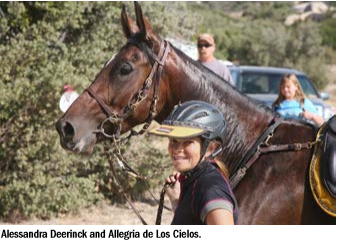
The Mangalarga Marchadores, as all the equine breeds, are the result of a careful genetic selection operated by man. The history of the breed can be traced to the age of Napoleon and the war against Portugal. Feeling the threat, the royal Portuguese family escaped to Brazil, where they remained and founded another kingdom. Along with the members of the royal family went some of their best horses from the Alter Real farm. Between them was the stallion Sublime, that was gifted to the Barão de Alfenas, in the wealthy state of Minas Gerais. Sublime, came to serve members of the Junqueira family, friends of the Imperator. The horse was crossed with Spanish Barb and Jennets mares from the Hacienda Campo Alegre, and became the originator of the Mangalarga Marchador horse. The Jennets were known for their confortable gait and were famous for being the horses of the Conquistadores. The MM breed has been maintained pure throughout time, to the contrary of some other more famous breeds, and in order to better its standards only pure bred individuals have been used, The name came from the Hacienda Mangalarga. The word means “wide sleeve”, term used to describe the movement in their gait, that makes it look like they are wearing a wide sleeve. The second part of their name comes from the name of their gait, the Marcha. The official registry of the breed was created in 1949, in Belo Horizonte, along with the ABCCMM (the Brazilian Breeders Association), which has the control of it and is under the direct supervision of the government of Brazil. There are very strict rules that set the standards for the Marcha and the mind disposition of these horses. In fact horses that do not have a good disposition are not allowed in the registry. No matter where in the world they are born, in addition to the pedigree, in order to be permanently registered, the horses have to be inspected and ridden by authorized judges, which can only be from the Brazilian office of the ABCCMM.
The Mangalarga Marchador ranges from 14,2 to 16 hands, averaging around 15 and is of medium built. The coat color is variable, only the cremello is not accepted by breed standard. In Brazil they are raised in a semi-wild situation, they thrive on natural pasture and live in herds of mares and young horses. The imported horses have done well on hay, in fact they are “easy keepers”, and Brazilian officers that have inspected our US bred horses have noticed that they are taller and larger than the original standards. They attribute this fact to the more detailed care and nutrition that the American breeders have taken in raising their horses. I feel it is because they are raised with hay, which has a much higher content in calories than green grass.
It is not by accident that the Brazilians cherish the perfection of this horse’s gait. In Brazil, the birthplace of the Mangalarga Marchadores, ranches are as big as an entire state and mountains are everywhere, so finding yourself in the saddle for hours is not unusual, and horseback is a common way to travel around. Worldwide, the breed has encountered the favor of anyone that has approached it.
The MM breed associations worldwide.
The MM has encountered the favor of the public in different parts of the world. These are the different breed associations worldwide:
- ABCCMM ((Associação Brasileira dos Criadores do Cavalo Mangalarga Marchador) www.abccmm.org.br
- USMMA (United States Mangalarga Marchadores Association) www.namarchador.org
- EAMM (European Association of Mangalarga Marchadores) www.eamm.de
- AIAMM (Associazione Italiana Allevatori di Mangalarga Marchadores) www.aiamm.it
The Marcha
The typical Mangalarga Marchador gait is called Marcha. There are two kinds of Marcha: “Picada” and “Batida”, which can be described in a simplistic way as a modified walk and trot. Both of them have times of triple hoof support alternate with double (diagonal and latera)l; there is no head bobbing as in some of the American breeds, or lateral movement of limbs (termino) as in the Peruvian Paso. The most important element is the rhythm and the definition of the moments of triple support and the fact that the horse has always a foot on the ground.
The Picada is a very smooth gait, but cannot compete in speed and energy efficiency with the trot. Instead, the Batida can actually compete in speed with the trot, and definitely beat it when it comes to efficiency on uphill and downhill and comfort for the rider. After all, this was one of the goals that the Brazilians pursued when they developed the breed genetics.
In Brazil, the Marcha has been studied in detail, breaking up the movement of each limb in: lift, dislocation and support, measuring every step for each limb and analyzing them in relation to the others. From this it emerged that the Mangalarga Marchador gait is so confortable and stable because of the almost complete absence of the phase of loft and because of the long phases of triple support.
In the Picada the horse is in the phase of double lateral support for a relevant time that can be visually noticed. This kind of footfall causes the back of the horse to be very still, and makes for a very comfortable ride in the saddle, almost free of movement. In the Batida, it is almost impossible to see the lateral phase, or sometimes to distinguish this gait from a trot. The horse can reach the speed of 15 miles per hour, and maintain it for long periods of time. A variation of the Batida is the Centered Batida, a gait of moderate speed that the horse can maintain for long periods and that gives the rider extreme comfort in medium and long distance trail rides.
The Marcha has a genetic base that came as the result of the environment, on the steep and rocky trails on the mountains in Brazil. In fact, the horses were forced, by the nature of the ground, to assume a non-symmetrical gait. As with any horse gait, other things that affect its quality are the interference of the rider, with its weight and the bit, and other artifacts, but the Mangalarga Marchador does not need to be taught to gait, the marcha is absolutely natural and the horse manifests it from the very beginning of its life. The same individual horse could have a preference for Picada or Batida, or perform all of them, if relaxed and helped just by regulating his speed.
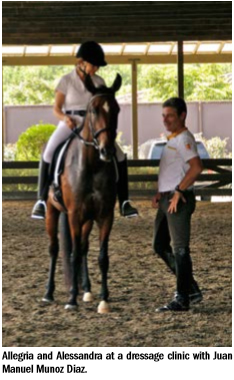
My experience with Allegria de los Cielos
January 1st 2016 I had the honor to ride Allegria de Los Cielos in the Rose Parade, with the AERC riders, after having won the title of MM Champion mare 2014 in Las Vegas, and having spent 2015 between endurance rides, cowboy dressage, rail shows, cowboy challenges, horsemanship demonstrations and of course parades.
Allegria and I have known each other for a long time. She is Rio’s full sister, and I already had her in training for the first endurance ride she did in 2012. She came back to me after a few years because of a problem in crossing water, which got resolved fast, and she ended up staying for much longer.
Going back in time, October 6th 2012 was a beautiful sunny day, ideal weather for an endurance ride in the backcountry of San Diego, the Manzanita LD Ride 2012. Allegria was six-year old at that time. She had mostly lived in her birthplace, except for a brief period when she was sent to Nevada to be put under saddle. Once back from Nevada, she has lived at Rancho de Los Cielos, in a pasture with four other mares, free to run and play.
The day I took Allegria in training, I knew the ride we wanted to do was only 45 days away, and that the horse had no conditioning for that. At her arrival I noticed that she was not nervous about being in the new place and was curious instead of stressed. This was a wonderful thing, considering that the problems I was going to face were many. Between them, I had a horse that was unshod, and I did not know how the mechanics of the available boots would work with her gait. In her first ride we went barefoot, but we are now planning on trying glue on Renegades in some of the rockier rides.
Allegria’s gait was different than any of the other gaited horses known in the US, and riding a gaited horse in endurance was definitely new for me. I had read that the energy expense for the horse that had her kind of gait, mainly Picada, is much higher than for the trot. To my advantage, many rides in the region where I live have a lot of mountain trail, with ups and downs, which are very favorable for the MM breed, in fact this was one of the reasons for the creation of this breed.
Allegria had no fitness base, but she lived in a pasture, where she was able to move all day long, a much better situation that if she was stabled in a small space. I did not have any specific literature to help me prepare a horse like her, and while I knew that there was probably a lot available, it was written in Portuguese. In fact, in Brazil the Mangalarga is widely used for endurance, but very few Marchadors have competed in endurance outside of their country of origin. In training Allegria I learned a lot about Mangalarga Marchadors, and had once again the chance to test how Human Horse Sensing builds horsemanship that works in the real situations..
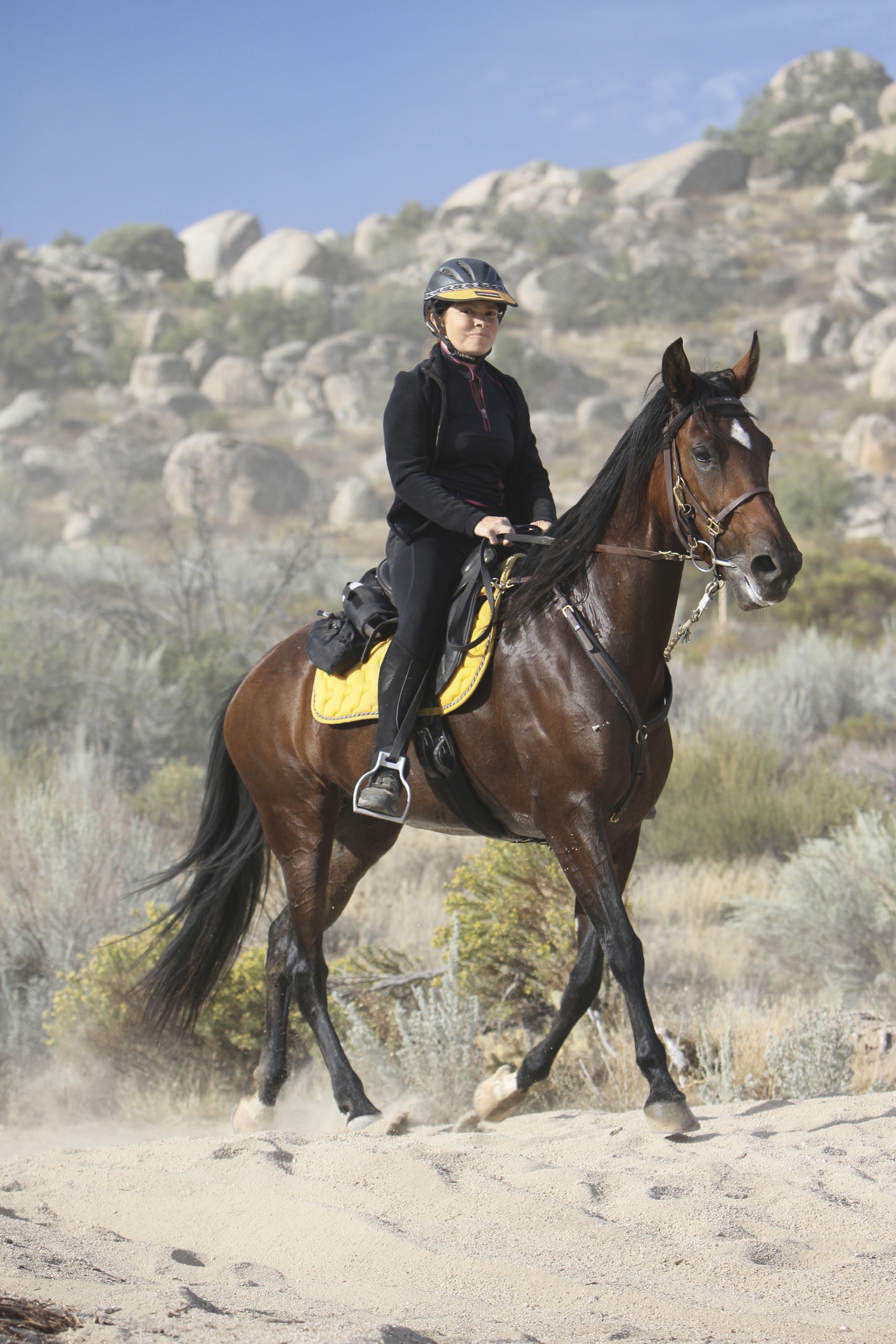
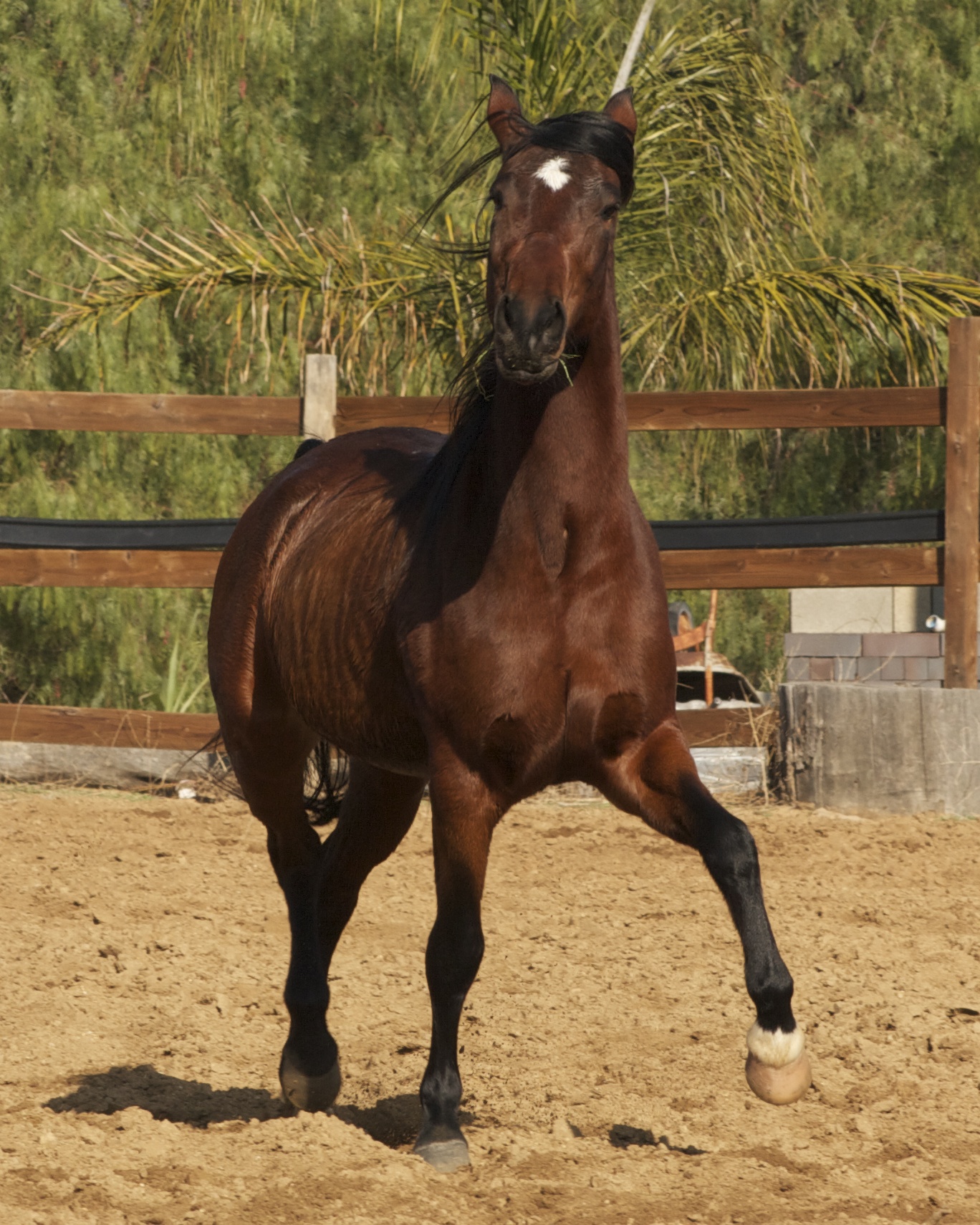
The facility where I was boarding in 2012 had a quarter mile circular galloping track and groomed trails, which helped us in reaching a good fitness level, along with interval training, which puts less wear and tear on the horse.. The horsemanship built with HH Sensing and practicing dressage filled in for the lack of trail experience, helping Allegria and I face the challenges of the endurance ride. Most importantly, I had to make sure that the training she was receiving was not going to hurt her. She underwent a lot of changes in a very short time, beginning with being stabled in a stall instead of the pasture, then to having her diet modified to fulfill the new needs for her activity. Her very attentive mind helped her in coping with all the changes. Just keeping a close eye on her limbs gave me an indication of how she was doing with the training. The response of a horse’s body is something I always respect, and I avoid using aids that would mask the real situation. Her joints did swell mildly in the training, as expected. When that happened we just took it easier and worked without tack, on getting in sync with each other and building our horsemanship from the ground up. I closely monitored her heart rate, but without using a heart monitor. With a new horse I prefer to just listen closely to her behavior and vital signs, rather than relying on technology, so I also get to know them better. Later, when a horse is trained and I know how he behaves in a race, having a heart monitor is a big advantage. Allegria’s fitness improved fast, and so did her ability to stay in gait for long periods of time.
Because of Allegria’s inexperience, I was practicing dressage, and even took her, spur of the moment, to a clinic given by Juan Manuel Munoz Diaz, an Olympic dressage rider from Spain. Allegria and I stood in for an injured horse that her owners originally planned to present. We were not really ready for such an important task, but Allegria acted like it was no big deal. Even the covered arena and the large audience did not upset her. This was an important confirmation of her wonderful lead mare personality, which I saw again in her reaction to "camping" with other horses, the night before the race. The Manzanita ride base camp offered corrals to house the horses, but they were very small and attached. Allegria was between two other horses. In the evening, when the horses were fed, she became very territorial. She kept the others away from the space where her food and water were, making some of them not be able to eat. Her neighbors had to stand as far away from her as possible, on the opposite side of their corrals, until she was done eating, then she became again the sweet mare I knew. After she was done eating, the vicinity of other horses was comforting for her, and I saw how important this was in the 2015 rides, where she was not comfortable at all being attached at the side of the trailer alone. I could not even leave her sight to drink a glass of water, or to have dinner. She would try to bolt away and get untied. I had to take her with me to the ride meetings, even when they were around a bon fire. She absolutely wanted to be at my side, but also enjoyed the attention of everyone else coming up to her.
She is very bonded to me, and bonding is another special trait of her breed. I do not own Allegria, but I feel like she is “my horse” more than many other horses I rode for much longer time. I was hesitant to believe her owner when she told me that MMs get jealous when “their human” rides other horses, but I had to believe her when I saw Allegria throwing temper tantrums if she sees me take other horses out to train. Having such a tight bond with a horse is great plus in endurance, where so much time is spent alone with our horse and being in sync is of great importance.
On the day of the Manzanita ride 2012, I saddled Allegria up while the riders of the 50 mile ride were leaving camp, then we calmly went to the start where the other 81 horses were lining up. She couldn't have been more focused, and I felt like we were one entity, able to choose the speed and gait, able to pass or let others pass us. It took us a little more than four hours to cover the distance, including portions of mountain tracks and steep up hills intermixed with downhill slopes and easier trail. Riding her felt very different than riding other horses. because of the fact that Allegria has always a foot on the ground, we were faster than most of the other horses on the slopes, but slowed down on the flat parts of the trail.
Allegria got all A's at every vet check and we finished 32nd. We mostly rode by ourselves, and only occasionally passing or being passed by other riders. At the vet checks, my little mare acted like a veteran, eating, drinking and calmly resting. It was so reassuring to see her drinking, a vital determinant for the health of an endurance horse, and a skill we worked on during her training by setting up buckets with water on the trails.
Our next ride did not go as smoothly, and we pulled out because she was in heat, but she did well at the Descanso Fall 2015, and just recently we placed 5th in the Bar H 2016 25 mile ride and are working to step up to the 50 mile rides.
The best times I had with Allegria are on the trails of the endurance rides, where she has a purpose to perform her wonderful gait, and because of those great moments, she has also learned to enjoy the time we spend in the sterile environment of the arena.
ABOUT HUMAN HORSE SENSING
Human Horse Sensing (www.HHSensing.com) is the result of the many years spent working with horses, racing as a jockey for twelve years, studying Veterinary Medicine, jumping, doing endurance, riding dressage and working without tack on the ground and in the saddle. It works through the roots of horse behavior, horse social relationships and how humans can communicate appropriately on the horses' own terms.
Genetics and physical ability aside, only a horse that likes what he does can be a real champion, and a seamless communication with the rider adds magic to the performance.
In HH Sensing there is no preset rule, the way a human and horse pair works is strictly related with how the two individuals perceive with their senses the situation they live, have lived, and will live together. In fact, horsemanship is never a set situation, other than when we are talking about training. Everything is dynamic and changing, as it would be in a relationship with a friend.
In Human Horse Sensing there are some simple parameters to monitor and manage, which make the horsemanship dynamic and clear. In “real life”, individuals receive information from what surrounds them through their senses (sight, hearing, touch, smell and taste), which never get shut down. The individuals elaborate the information and express themselves by the way they behave. Between two individuals, the leader is the one that has the whole plan in his mind. In every moment together and in every interaction both individuals build memories that will inevitably affect their future. In this kind of dialogue a horse can be a follower without being submissive; a rider can be a leader of leaders.
This article originally appeared on AERC Summer Vol 7 and is published here with permission.
You can find more interesting articles in our section on Riding Disciplines.









